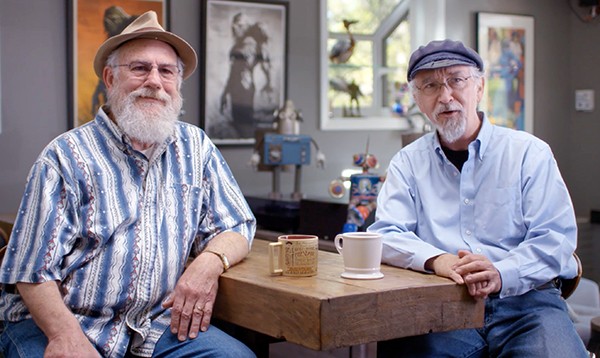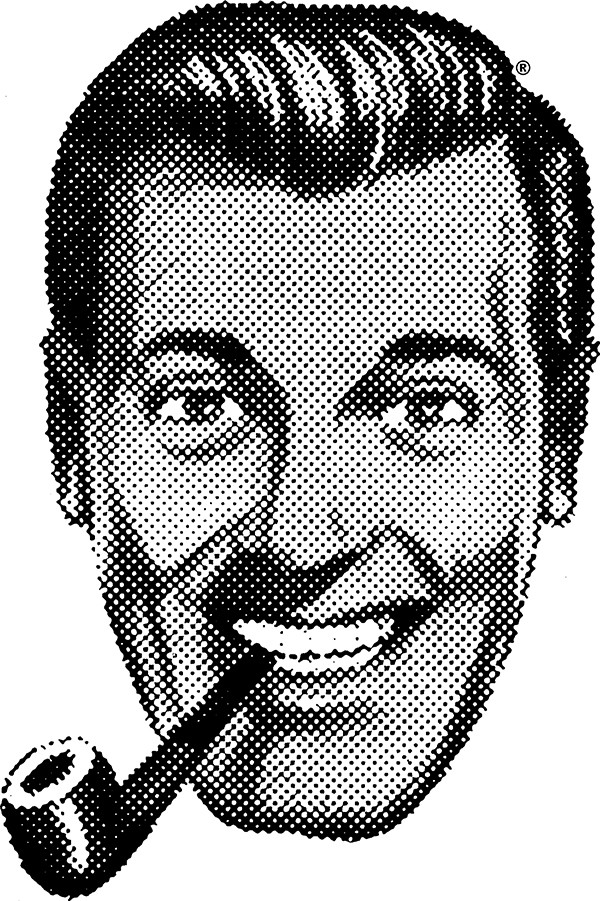“The World Ends Tomorrow and YOU MAY DIE!” So begins SubGenius Pamphlet #1, the mysterious missive that launched J.R. “Bob” Dobbs into the cultural consciousness. The story of the unlikely creation of the Church of the SubGenius and its sprawling influence is told in a new documentary by producer/director Sandy K. Boone.
The “church” was the brainchild of two friends from Fort Worth, Texas. Douglass St. Clair Smith had been voted “weirdest” student in his high school. Steve Wilcox worked for AT&T. They were both self-proclaimed outsiders in the straight-laced Texas of the late 1970s, so when they met, they became fast friends.

Slackers — Dr. Philo Drummond (left) and Rev. Ivan Stang come clean in J.R. “Bob” Dobbs and the Church of the SubGenius.
The two were fascinated with all kinds of extreme beliefs and outsider art. They bonded over a common love of the psychedelic music of Captain Beefheart. This was the age of televangelists and the rise of Evangelical Christianity. Wilcox had been raised in a fundamentalist household and was intimately familiar with the culture, even though he rejected his parents’ religion.
The idea was to create a parody version of the pamphlets and flyers, such as the tracts from cartoonist Jack Chick, that littered public spaces in Fort Worth, so they created a fake religion that was supposed to seem just as insane as the kooky pamphlets they were satirizing. To do that, they needed a deity. Since their own artistic skills weren’t up to snuff, and they couldn’t afford to hire an illustrator, they turned to clip art, the open source IP of the day. In a book from the 1950s intended for use by salesmen, they found an image of a smiling white man clenching a pipe in his teeth. They named the image J.R. “Bob” Dobbs, and invented a backstory for him.

“Bob” (the quotation marks were mandatory) was a supernaturally gifted salesman who was contacted in the 1950s by a “wrathful alien space god from a corporate sin galaxy” who called himself JHVH-1. The mission of “Bob” was to bring Slack to the world. What Slack was, exactly, was left to the imagination, but in Wilcox’s words, “You know when you don’t have it.”
All religions need an adversary. The target audience for the pamphlet was defined on the front page: “Do people think you’re strange? Do you???” Since the two artists were in Dallas, conspiracy theories about the assassination of John F. Kennedy were fresh on their minds. Thus, the Conspiracy of Normals, intent on stealing Slack from the abnormals, was conjured into existence.
Smith renamed himself Rev. Ivan Stang, and Wilcox adopted the moniker Dr. Philo Drummond. The pamphlet included an address for the SubGenius Foundation with a pitch to send $1 in return for “Eternal salvation or triple your money back!” As Ivan Stang says in one of the many archival interviews in the documentary, “If Jim Jones convinced 900 people to kill themselves, we thought maybe we could convince 900 people to give us a dollar.”
Much to their surprise, they convinced a lot more than 900 people. Word spread quickly, and a network of artists creating copycat artworks sprang up around the country. “Bob” became an icon of ’80s counterculture. The first meeting of the SubGenius, which Stang dubbed a “devival,” attracted Devo founders Mark Mothersbaugh and Jerry Casale. A radio show called The Hour of Slack soon followed. “Bob” popped up in the oddest places, such as on the wall of the set of Peewee’s Playhouse. Baffled journalists didn’t know if the SubGenius crew was joking or not, and Ivan Stang, who took over running the ramshackle church, wasn’t about to tell them. The devivals became chaotic touring shows, with bands like Doktors for Bob pioneering what would become known as noise music.
As Boone’s insightful and spritely paced documentary reveals, the genius of the SubGenius was deconstructing the elements all real religions shared and reconstructing them in a funhouse mirror. But much to Stang’s dismay, he found that even a parody religion attracted sincere followers. At a massive devival in San Francisco known as The Night of Slack, Stang was accosted by a SubG who demanded to know where the real “Bob” was. Like any religion worth its creed, schisms developed, and people took the “us vs. them” narrative way too seriously. In the documentary, Stang says he decided to break character and tell the real story of the church in order to avoid creating a new Scientology after he’s gone.
In many ways, the SubGenius were ahead of their time. The church was an early adopter of the internet, and “Bob” is a proto-meme. Slack lives on as the name of a popular business conferencing app. But as the documentary points out in its closing minutes, cult-like organizations such as QAnon learned the wrong lessons from the SubGenius: No matter how nutty a group seems, if it gives them a sense of belonging, people are willing to believe.
J.R. “Bob” Dobbs and the Church of the SubGenius is available on Amazon Prime Video and Vimeo On Demand.
 Creation Museum
Creation Museum